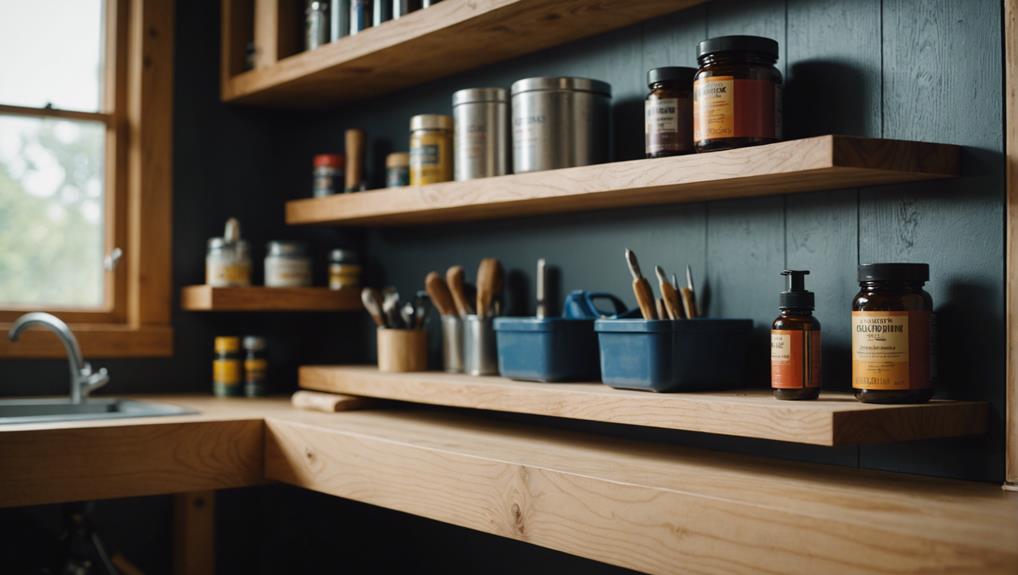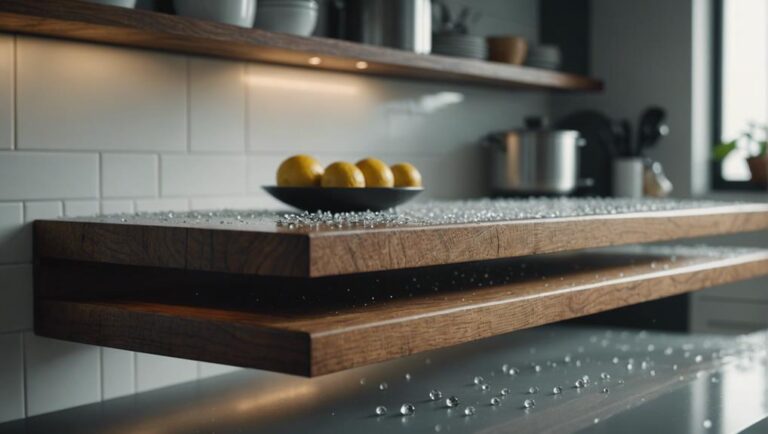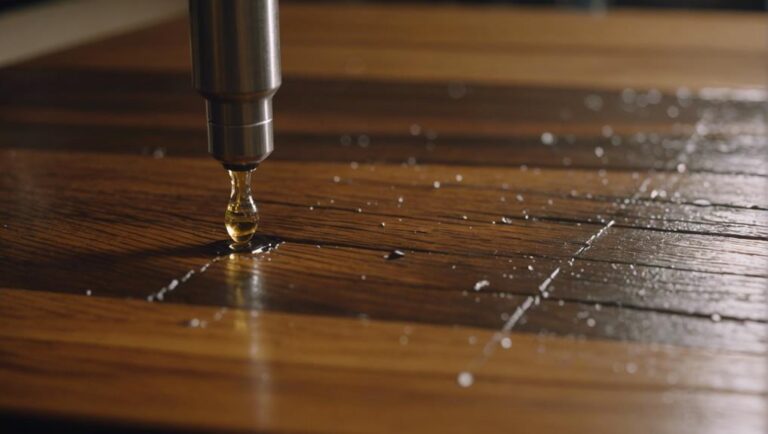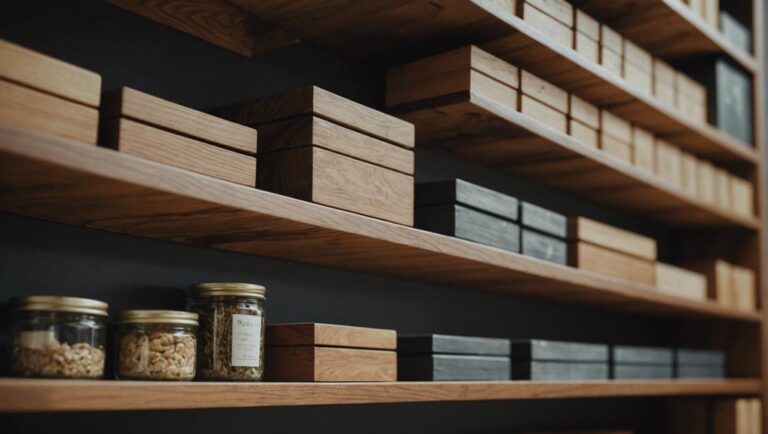Comparing Oil-Based Vs Water-Based Wood Sealants for Floating Wood Shelves

When considering oil-based versus water-based sealants for floating wood shelves, it's essential to weigh various factors. Water-based sealants dry rapidly, have minimal odor, and clean up easily with water, making them convenient for shelf projects. They provide a clear finish, but their durability may not match up to oil-based options.
On the other hand, oil-based sealants offer superior durability and water resistance, enhancing the wood's natural color and grain. However, they require a longer drying time and emit a stronger odor during application.
Varathane and General Finishes are renowned brands in their respective categories, ensuring reliable outcomes for your wood shelf protection needs. For further insights, let's delve into popular brands and user testimonials for a comprehensive evaluation.
Key Takeaways
Water-based sealants dry rapidly, making them perfect for projects with tight deadlines. They are known for their quick drying time, allowing for efficient completion of floating wood shelves. On the other hand, oil-based sealants provide unparalleled durability and water resistance, significantly extending the lifespan of the shelves. This superior protection ensures that the shelves remain in top condition for a long time, even in challenging environments.
Water-based sealants have minimal scent and can be easily cleaned with water, creating a more pleasant application process. This feature makes them an appealing choice for those who value a hassle-free experience when working on their floating wood shelves. In contrast, oil-based sealants enrich the natural hues and patterns of the wood, resulting in a more opulent and sophisticated appearance. By enhancing the wood's color and grain, oil-based sealants contribute to a luxurious finish that can elevate the overall aesthetic of the shelves.
When it comes to application, water-based sealants are simpler to apply smoothly and evenly, making them well-suited for achieving a clear and resilient finish on floating shelves. Their ease of application ensures a professional-looking result without the need for extensive expertise. In comparison, oil-based sealants may require more attention to detail during application to achieve the desired outcome. Ultimately, the choice between water-based and oil-based sealants for floating wood shelves depends on factors such as desired finish, ease of application, and level of protection required.
Key Differences
When choosing between oil-based and water-based wood sealants for your floating wood shelves, it's essential to understand the differences in terms of finish, durability, and environmental impact. The choice between water-based and oil-based polyurethane is crucial for those looking to enhance their floating wood shelf projects.
In terms of drying time, oil-based sealants take longer to dry and cure compared to water-based options. This can impact the speed at which you can complete your project without compromising on quality.
On the other hand, water-based sealants dry much faster, allowing for quicker project completion. Additionally, water-based sealants are more environmentally friendly due to their lower VOC content, resulting in a reduced odor and easier cleanup, which is a significant advantage for environmentally-conscious individuals.
When it comes to durability, oil-based sealants typically offer a more robust and long-lasting finish, making them suitable for high-traffic areas or shelves that will be heavily used.
However, water-based sealants don't yellow over time, preserving the natural look of lighter woods, which is a valuable characteristic for maintaining the aesthetic appeal of your floating wood shelves.
Appearance and Finish
When choosing a sealant for our floating wood shelves, it's essential to consider the gloss, sheen, and color enhancement properties of each option.
Oil-based sealants can provide a deep, amber hue that darkens the wood, resulting in a classic and cozy appearance.
In contrast, water-based sealants offer a clear finish that maintains the natural color of the wood, ideal for those who prefer a light or white look for their shelves.
Gloss and Sheen Levels
Choosing the right gloss and sheen level for wood sealants plays a crucial role in achieving the desired appearance and finish of floating wood shelves. Oil-based stains typically offer a high gloss and sheen level, creating a warm, amber hue that enhances the natural color and depth of the wood. This results in a striking and rich finish, elevating the aesthetic appeal of any space.
On the other hand, water-based polyurethane provides a clear finish that doesn't yellow over time, preserving the wood's original appearance. It excels in achieving a satin or matte finish, offering a more subtle and understated sheen compared to oil-based products. This makes it an excellent choice for those seeking a minimalist and modern look for their floating shelves.
The decision between these options ultimately depends on personal preference and the desired ambiance of the room. For a more traditional and luxurious feel, the high gloss of an oil-based stain may be ideal. Conversely, if you prefer a contemporary and sleek design, the satin or matte finish of water-based polyurethane could be the perfect fit.
Both options have distinct advantages, ensuring that your floating wood shelves look stunning in any setting.
Color Enhancement Effects
Oil-based and water-based sealants offer distinct color enhancement effects that significantly influence the appearance of floating wood shelves. When utilizing oil-based sealants, a warm, amber hue is immediately noticeable, intensifying the natural colors of the wood and imparting a rich, classic finish. This enhancement deepens over time, creating a glossy sheen that adds depth and character to the wood surfaces, appealing to those with a penchant for traditional aesthetics.
In contrast, water-based sealants maintain the wood's original color without any yellowing, providing a clear and sharp look that aligns well with modern, minimalist styles. The retention of the wood's natural hue, combined with the protective properties of water-based sealants, makes them a favored choice for individuals seeking a clean and unadulterated appearance in their wood finishes.
The decision between oil-based and water-based sealants boils down to the desired aesthetic for floating wood shelves. While oil-based sealants offer a timeless, amber-infused look, water-based options present a transparent and authentic appeal. Each type of sealant caters to different style preferences, enhancing the beauty of wood in distinctive ways.
Durability
When evaluating the durability of wood sealants for floating shelves, it becomes apparent that oil-based options generally provide superior longevity under stress and exceptional resistance to moisture.
In contrast, water-based sealants may necessitate multiple coats to achieve a similar level of durability but often lack the ability to withstand wear and tear over time.
Longevity Under Stress
In high-stress settings, floating wood shelves benefit from the increased durability provided by oil-based sealants. When dealing with heavy items or frequent handling, oil-based polyurethane offers superior longevity compared to water-based options. This heightened durability is crucial for preserving the structural integrity of the shelves over time.
Oil-based sealants typically necessitate fewer applications, making them efficient for both initial use and long-term maintenance. They create a strong protective barrier that can withstand wear and tear more effectively than water-based alternatives. Although water-based polyurethane has made advancements, it may still require multiple layers to achieve a similar level of resilience, which can be less efficient in high-stress scenarios.
When considering innovative solutions, the selection between oil-based polyurethane and water-based sealants should take into account the specific requirements of our floating wood shelves. Here is a summary of the key distinctions:
| Sealant Type | Durability | Coats Needed |
|---|---|---|
| Oil-Based Poly | High | Fewer |
| Water-Based Polyurethane | Moderate | More |
Resistance to Moisture
Oil-based sealants are known for their exceptional performance in high-stress environments, but we must also consider their moisture resistance to ensure the longevity of our floating wood shelves in humid conditions. Both oil-based and water-based sealants create a protective barrier against moisture, preventing issues like warping or rotting. However, the effectiveness of each type varies significantly.
Water-based wood sealants offer impressive moisture resistance, safeguarding our floating wood shelves against water damage and humidity. Their quick drying time ensures that shelves are shielded from moisture promptly, making them a practical choice for those prioritizing swift protection. This rapid application process is well-suited for modern home improvement projects where time efficiency is crucial.
Conversely, oil-based wood sealants establish a sturdy barrier against moisture, making them an excellent choice for areas susceptible to high humidity, such as kitchens or bathrooms. Although they may require more time to cure for optimal moisture protection, the result is a resilient, long-lasting defense against moisture. While the extended curing period can affect the shelf's durability in humid settings, the enhanced protection it provides justifies the wait.
Wear and Tear
When selecting a sealant for our floating wood shelves, it's essential to consider durability. Oil-based wood sealants tend to outperform water-based ones in terms of wear and tear resistance. They're less prone to scratches and abrasions, making them a better choice for shelves that undergo frequent handling and heavy loads.
Although water-based sealants are improving in durability, they still tend to scratch more easily and may not offer the same level of protection against sharp objects. This might necessitate applying multiple coats to achieve a similar level of defense. For those seeking long-lasting and robust protection for their floating wood shelves, oil-based sealants are the preferred option.
While water-based sealants are advancing in resilience, oil-based options remain superior for high-traffic areas. By considering the wear and tear our shelves will endure, it becomes clear that oil-based sealants provide a more durable solution, ensuring the shelves retain their pristine appearance and structural integrity over time.
Choosing the right sealant can effectively extend the lifespan and beauty of our floating wood shelves.
Water Resistance
Water-based wood sealants provide reliable protection for floating wood shelves against moisture damage. These sealants effectively repel water, ensuring that our shelves maintain their integrity even in humid conditions.
When comparing water resistance between water-based and oil-based sealants, both options offer solid defense against moisture. However, oil-based sealants may provide slightly better water resistance. Despite this, water-based sealants are often recommended for superior overall protection.
The choice to lean towards water-based sealants is influenced by their innovative formulations that establish a strong barrier against water while allowing the wood to breathe. This feature helps prevent issues like swelling or warping, ensuring the longevity of the shelves.
Properly sealed floating wood shelves with water-based products can withstand water exposure without compromising their structural integrity, making them ideal for areas prone to humidity.
In addition to their protective qualities, water-based sealants are more environmentally friendly compared to oil-based options. This aligns with our commitment to sustainable practices. Opting for water-based sealants not only offers excellent moisture protection but also contributes to reducing the environmental footprint.
For those seeking durable floating wood shelves, choosing water-based sealants for their exceptional water resistance is a forward-thinking decision.
Drying Time
Water-based sealants dry quickly, typically within 1-2 hours, making them a top choice for those seeking efficient project completion.
In comparison, oil-based sealants take 4-6 hours to dry, prolonging the timeline.
This distinction allows users of water-based options to reduce the risk of dust settling on the surface, leading to a cleaner finish in less time.
Faster Water-Based Drying
When sealing floating wood shelves, opting for water-based polyurethanes can significantly speed up the process. These sealants typically dry rapidly, often within 10 minutes, allowing for quick progress and efficient completion of the project. This quick drying feature not only saves time but also reduces the likelihood of dust or debris settling on the surface, resulting in a cleaner and more professional finish.
Here are four advantages of using water-based sealants for floating wood shelves:
- Swift Drying: Water-based polyurethanes dry in under 10 minutes, enabling seamless continuation of the project without extended waiting periods.
- Improved Productivity: The fast drying time enables multiple coats to be applied in a single day, streamlining the sealing process.
- Enhanced Finish: Rapid drying reduces the risk of contaminants landing on the surface, contributing to a smoother and cleaner end result.
- Convenience: With quicker drying times, there's less disruption to daily activities, making water-based sealants a practical choice for home woodworking projects.
Oil-Based Longer Curing
While water-based polyurethanes dry fast, oil-based sealants have the benefit of a longer curing period, leading to a more durable and elegant finish. Choosing an oil-based sealant means waiting for it to cure, typically between 24 to 48 hours. This extended curing time allows the sealant to harden completely, forming a strong protective layer. By taking the time for this process, we can enhance the natural beauty of our floating wood shelves, ensuring they maintain their appearance for years to come.
The extended curing time of oil-based sealants goes beyond just being patient; it's about achieving a superior outcome. As the sealant dries slowly, it deeply penetrates the wood, offering lasting protection against damage. This results in shelves that not only look more luxurious but also withstand daily use better. The wait for the durability and quality of the finish is often worthwhile, particularly for those who appreciate top-notch results in their home projects.
Odor Levels
When choosing wood sealants for our floating shelves, it's essential to consider the odor levels associated with each type. The difference between oil-based and water-based polys is crucial for indoor air quality and overall comfort.
Oil-based sealants are known for their intense, sharp odor, which can be overwhelming during application. This strong smell often necessitates good ventilation and can linger in the air for an extended period.
On the other hand, water-based polys offer a more pleasant experience with minimal to no odor, making them ideal for indoor use, especially in confined spaces like kitchens or bathrooms.
Here are the key considerations:
- Odor Strength: Oil-based sealants have a potent smell, while water-based polys are nearly odorless.
- Ventilation Requirements: Oil-based options need ample ventilation, while water-based options are suitable for enclosed areas.
- Indoor Application: Water-based sealants are preferable for living spaces to prevent lingering odors.
- Application Comfort: Opting for a water-based sealant enhances comfort during the application process due to the absence of strong odors.
Cleanup Process
Water-based wood sealants offer a significant advantage in the cleanup department. With just soap and water, these sealants can be effortlessly cleaned up, making them a top choice for home improvement projects. Say goodbye to the hassle of dealing with harsh chemicals or worrying about unpleasant lingering odors.
A simple mixture of soap and water is all that's needed, ensuring a quick and environmentally friendly cleanup process.
In contrast, oil-based wood sealants require the use of mineral spirits or paint thinner for cleanup. This method is more time-consuming and necessitates proper ventilation due to the strong chemical odors involved.
When it comes to efficiency and sustainability, water-based sealants clearly take the lead. The easy cleanup saves valuable time and effort, allowing for a focus on the creative aspects of crafting floating wood shelves.
Additionally, the reduced reliance on specialized cleaning agents means fewer trips to the store and less exposure to potentially harmful substances. This straightforward cleanup process resonates well with modern, eco-conscious lifestyles, guaranteeing that projects are both innovative and environmentally responsible.
Therefore, when evaluating cleanup convenience, water-based sealants stand out as the superior choice.
Number of Coats
Choosing the right number of coats for wood sealants is crucial for ensuring the best protection and finish for floating wood shelves. When comparing oil-based and water-based wood sealants, it's important to consider the number of coats needed for optimal coverage and durability.
Oil-based sealants typically require fewer coats due to their thicker consistency. One or two coats are often sufficient to create a strong, protective layer on floating wood shelves, saving time and effort in the application process.
On the other hand, water-based sealants generally require more coats to achieve the same level of protection as oil-based options. It may be necessary to apply three or more coats to ensure similar durability and finish on the shelves.
The number of coats needed can also vary depending on the type of wood used for the floating shelves. Softer woods may absorb sealants differently than harder woods, potentially requiring additional coats for complete protection.
Additionally, the desired finish plays a role in determining the number of coats needed. For a glossier and more polished appearance, extra coats may be necessary, especially when using water-based sealants.
Application Techniques
When applying wood sealants to floating wood shelves, it's important to use specific techniques to ensure an even and long-lasting finish. For oil-based sealants, you can choose to apply them with a brush, roller, spray, or rag to achieve consistent coverage. These sealants have a longer curing time, allowing you more flexibility to work the product into the wood surface carefully. This extended time frame enables you to focus on precise application, ensuring each stroke is smooth and uniform.
On the other hand, when working with water-based sealants, the process requires a bit more speed and accuracy. These sealants dry and cure more quickly, so it's essential to apply them efficiently and swiftly to prevent streaks or bubbles. Whether you opt for a brush or spray application, maintaining a steady hand and paying attention to detail is crucial for a flawless finish.
Regardless of the type of sealant you choose, it's important to apply it properly to guarantee a durable and protective coating on your floating wood shelves. Taking the time to perfect your application techniques, whether using a brush, roller, or spray, will ensure the longevity and visual appeal of your shelves.
Environmental Impact
Understanding the importance of environmental considerations in selecting wood sealants for floating wood shelves is crucial. Considering how our choices impact both our well-being and the planet is essential. Opting for water-based wood sealants is a wise decision due to their significantly lower volatile organic compound (VOC) emissions compared to oil-based options.
Here are four key points to keep in mind regarding the environmental impact of wood sealants:
- Reduced VOC Emissions: Water-based sealants have been shown to emit up to 50% fewer VOCs, leading to improved indoor air quality and reduced harm to the environment.
- Enhanced Safety: The absence of harmful solvents in water-based sealants not only reduces health risks for users but also creates a safer working environment during application.
- Promoting Sustainability: Opting for water-based sealants minimizes exposure to hazardous chemicals, contributing to a more sustainable approach to wood finishing practices.
- Non-Flammable Properties: Water-based sealants are non-flammable, reducing the risk of fire hazards and ensuring overall safety during both application and storage.
Cost Comparison
Let's compare the initial costs and long-term benefits of using oil-based versus water-based wood sealants for our floating shelves.
While oil-based options may appear more budget-friendly at first, we must consider the potential savings and lower maintenance expenses associated with water-based sealants.
Upfront Expense Analysis
When assessing the upfront costs of wood sealants for floating shelves, it's crucial to consider not just the initial price but also the coverage area and the number of coats required. Both oil-based and water-based sealants present distinct cost considerations that can impact our decision-making process.
The initial purchase price of oil-based sealants is typically lower compared to water-based options. However, it's essential to remember that a lower price doesn't always equate to better quality, particularly in terms of long-term performance.
In terms of coverage area, oil-based sealants usually offer superior coverage per gallon, meaning fewer cans are needed for larger projects. Conversely, water-based sealants may require a greater quantity to achieve the same coverage area.
When it comes to the number of coats needed, oil-based sealants generally require fewer coats to achieve a durable finish. On the other hand, water-based sealants might necessitate more coats. Nonetheless, water-based options boast faster drying times, enabling us to complete the project more quickly.
Additionally, it's important to factor in any additional tools or equipment that may be required. Oil-based sealants could necessitate specialized brushes and solvents for cleanup, which can contribute to the overall upfront expenses.
Long-Term Value
When considering the long-term value of wood sealants for floating wood shelves, it's clear that oil-based options offer superior durability and require less frequent maintenance compared to water-based sealants. Despite the higher initial cost of oil-based sealants, their robust protection means less frequent reapplications are needed. This results in lower maintenance costs over the lifespan of the shelves.
On the other hand, water-based sealants may be more budget-friendly initially, but they often require more frequent reapplication. The additional maintenance tasks can accumulate over time, potentially nullifying the initial cost savings. In the grand scheme of the wood shelves' lifespan, the long-term benefits of oil-based sealants shine through. Their durability ensures prolonged protection, reducing the overall time and effort required for upkeep.
For individuals looking for innovative and cost-effective solutions, it's crucial to weigh the upfront expense against the long-term advantages. Oil-based sealants, with their exceptional durability and extended protection, make a compelling argument for the higher initial investment. By prioritizing long-term value, we can ensure that our floating wood shelves retain their beauty and resilience for years to come.
Shelf Longevity
To ensure our floating wood shelves last a long time, it's crucial to choose the right sealant. When deciding between an oil-based stain and a water-based sealant, we need to weigh the impact each option has on durability and appearance in the long run.
Water-based sealants are renowned for their ability to protect against stains, spills, and water damage, making them an ideal choice for maintaining shelf longevity. On the other hand, oil-based stains can enhance the color and depth of wood shelves, potentially contributing to their long-term durability by deeply penetrating the wood fibers.
Let's look at the advantages:
- Protection: Water-based sealants shield against daily wear and tear, preventing water damage and stains.
- Aesthetic: Oil-based stains enhance the natural color and grain of the wood, adding depth and visual appeal.
- Maintenance: Well-sealed shelves, whether with oil-based or water-based products, reduce the need for frequent upkeep.
- Efficiency: Water-based sealants dry quickly, allowing for efficient application and long-lasting protection.
Ease of Use
When it comes to DIY projects like floating wood shelves, opting for water-based sealants is a smart choice. These sealants dry quickly and are easy to clean up, making the whole process faster and more convenient. Water-based sealants can be easily washed off with water, simplifying the post-application cleanup and saving time. This appeals to those of us who value efficiency and simplicity in our home improvement projects.
On the other hand, oil-based sealants, while offering precise control during application, require more time and effort. Their longer drying times mean you need to plan your project meticulously, often waiting for extended periods before adding more coats or using the shelves. Cleanup with oil-based sealants involves using mineral spirits, which adds an extra step and can be cumbersome.
In a nutshell:
| Aspect | Water-Based Sealants | Oil-Based Sealants |
|---|---|---|
| Drying Time | Quick | Longer |
| Cleanup | Easy with water | Requires mineral spirits |
| Application Ease | Smooth and efficient | More controlled but time-consuming |
In the realm of floating wood shelves, water-based sealants are the preferred choice due to their user-friendly nature and quick results. For those looking for practical and easy-to-use solutions, water-based options offer a clear advantage.
Popular Brands
Let's delve into some top-notch brands that offer dependable sealants for your floating wood shelves, ensuring your DIY projects are efficient and top-notch.
- Varathane: Renowned for its premium oil-based wood sealants, Varathane delivers exceptional durability and a luxurious finish that effectively safeguards your floating wood shelves. Perfect for those seeking a timeless, sturdy sealant.
- Minwax: With a diverse range of oil-based and water-based wood sealants, Minwax caters to a variety of project requirements. Whether you desire the profound, penetrating protection of oil-based options or the speedy-drying convenience of water-based sealants, Minwax has you sorted.
- General Finishes: Known for its top-tier water-based sealants, General Finishes provides resilient and crystal-clear finishes that are ideal for floating wood shelves. Their water-based selections are particularly favored for their minimal odor and effortless clean-up.
- Rust-Oleum: Offering an array of oil-based and water-based wood sealants, Rust-Oleum presents multiple finishes, from matte to glossy, ensuring your floating shelves not only remain safeguarded but also exude elegance.
These brands epitomize innovation and dependability in the realm of wood sealants, catering to both traditionalists and modernists with their diverse offerings.
User Reviews
Users love the quick drying time and minimal odor of water-based sealants for floating wood shelves. These qualities are especially appealing to DIY enthusiasts who value efficiency and a pleasant working environment. Additionally, the easy application and cleanup of water-based options make them a top choice among users.
On the other hand, oil-based sealants receive praise for their durability and exceptional water resistance. They're the preferred option for high-traffic areas or spaces with moisture concerns. Users often mention how oil-based sealants enhance the natural color and grain of the wood, providing a luxurious and visually appealing finish.
Ultimately, the decision between water and oil-based sealants often boils down to personal preference. Some users prioritize the quick drying time and low odor of water-based choices, while others appreciate the long-lasting durability and enhanced wood appearance offered by oil-based sealants.
Both types have their unique advantages, so it's important to consider the specific needs and conditions of your floating wood shelves when choosing a sealant. The diverse perspectives in user reviews showcase the versatility and varied benefits of both water and oil-based sealants.
Frequently Asked Questions
Is Oil-Based Wood Sealer Better Than Water-Based?
When comparing oil-based and water-based sealants for floating wood shelves, the durability scale tips in favor of oil-based options. These sealants provide long-lasting protection against moisture, wear, and scratches, making them ideal for shelves in high-traffic areas. On the other hand, water-based sealants offer easier application, making them more user-friendly, especially for DIY projects.
The choice between oil-based and water-based sealants ultimately depends on your priorities for your floating wood shelves. If you prioritize longevity and maximum protection, oil-based sealants are the way to go. They form a strong barrier that can withstand the test of time and frequent use. However, if you value ease of application and a more environmentally friendly option, water-based sealants offer a more innovative solution.
Is It Better to Use Water-Based or Oil-Based Polyurethane?
When choosing a sealant or protective coating for floating wood shelves, it's essential to consider factors like drying time and color preservation. Water-based polyurethane is known for its quick drying time and resistance to yellowing over time. On the other hand, oil-based polyurethane offers a warm and durable finish, although it takes longer to dry.
Water-based polyurethane is a popular choice for those looking for efficiency and a clear, non-yellowing finish. It is easy to apply and dries relatively quickly, allowing for a faster turnaround time when working on projects. Additionally, it is less likely to alter the natural color of the wood, making it a preferred option for those who want to maintain the original look of their shelves.
In contrast, oil-based polyurethane provides a warm, rich tone to wood surfaces, enhancing their natural beauty. While it may take longer to dry compared to water-based alternatives, oil-based polyurethane offers superior durability and protection. This makes it a suitable choice for shelves that are exposed to heavy wear and tear or frequent use.
Ultimately, the choice between water-based and oil-based polyurethane for floating wood shelves depends on your specific needs and preferences. If you prioritize efficiency and color preservation, water-based polyurethane may be the way to go. However, if you value durability and a warm finish, oil-based polyurethane could be the better option for your project.
What Is the Main Disadvantage of Using Water-Based Polyurethane?
The primary drawback of utilizing water-based polyurethane for sealing floating wood shelves is its decreased longevity. This coating is more prone to scratches and wear, which can compromise the shelf's appearance and structural integrity over time. In addition, water-based polyurethane tends to have extended drying periods, requiring more time and patience during the application process.
While water-based polyurethane does offer the benefit of avoiding the yellowing effect commonly seen with oil-based alternatives, its lower resistance to everyday wear and tear can be a significant concern for those looking for long-lasting protection for their wood shelves. It is essential to consider the trade-offs between durability and other advantages when selecting the most suitable sealant for your floating wood shelves.
What Is the Downside of Oil-Based Polyurethane?
Did you know oil-based polyurethane can take up to 24 hours to dry? This extended drying time could be a drawback for those looking for a quicker solution when sealing their floating wood shelves. Additionally, the use of hazardous solvents in oil-based polyurethane can have a significant environmental impact, making it less appealing for individuals seeking more sustainable and eco-friendly options for protecting their wooden shelves.
One alternative to oil-based polyurethane is water-based polyurethane, which typically dries faster and has a lower environmental impact due to its reduced use of harmful solvents. Water-based polyurethane is a popular choice for those looking to seal and protect their wooden shelves while also considering the environmental consequences of their choices. By opting for water-based polyurethane, you can achieve a quicker drying time and contribute to a more eco-friendly approach to wood sealing.
Conclusion
When considering the best sealant for your floating wood shelves, it's important to weigh the advantages of oil-based and water-based options. Oil-based sealants are known for their luxurious finish and exceptional durability, ideal for protecting your shelves against wear and tear.
On the other hand, water-based sealants offer the benefit of quick drying times and easy cleanup, making them a convenient choice for those looking for a hassle-free application process.
The decision between oil-based and water-based wood sealants ultimately depends on your environmental considerations and desired aesthetic. If you prioritize a rich, long-lasting finish, an oil-based sealant may be the best choice for enhancing the natural beauty of your wood shelves. However, if you value convenience and ease of application, a water-based sealant could be the perfect fit for maintaining the pristine look of your floating shelves.
In conclusion, the selection of the right sealant for your floating wood shelves should be based on your specific needs and preferences. Whether you opt for the luxurious durability of an oil-based sealant or the quick-drying convenience of a water-based option, ensuring that your shelves are properly protected will help them remain a standout feature in your space for years to come.






